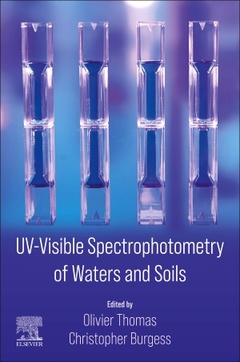UV-Visible Spectrophotometry of Waters and Soils (3rd Ed.)
Coordonnateurs : Thomas Olivier, Burgess Christopher

UV-Visible Spectrophotometry of Waters and Soils, Third Edition presents the latest information on the use of UV spectrophotometry for environmental quality monitoring. Using practical examples, the book illustrates how this technique can be a source of new methods of characterization and measurement. Easy and fast to run, this simple and robust analytical technique is one of the best ways to obtain a quantitative estimation of specific or aggregate parameters (e.g., Nitrate, TOC) and simultaneously qualitative information on the global composition of waters and soils. This third edition presents current methods and applications for water quality monitoring, including recent works and developments.
Writing from years of experience in the development and applications of UV systems and from scientific and technical works, the book's authors provide several useful examples that show the great interest of UV spectrophotometry for water and soil monitoring. At the end of the book, the UV spectra library of previous editions is updated with new chemicals of interest.
2. The Basics for good Spectrophotometric UV-visible Measurements
3. From Spectra to Qualitative and Quantitative Results
4. Organic Constituents
5. Aggregate Organic Constituents
6. Mineral Constituents
7. Physical and Aggregate Properties
8. Natural Water Quality
9. Natural Water, High Frequency Monitoring
10. Drinking Water Production
11. Urban Wastewater
12. Industrial Wastewater
13. Polluted Soils and leachates
14. Agricultural soils, natural Soils and sediments
15. UV Spectra Library
Christopher Burgess was a Visiting Professor at the University of Strathclyde, Strathclyde Institute of Pharmacy and Biomedical Sciences; an elected member of the United States Pharmacopeia Council of Experts 2010 to 2020, and a member of the Expert Committee on Validation and Verification of analytical procedures.
He is an internationally recognized expert in the qualification and validation of instrumentation and systems, analytical method development and validation and the statistical interpretation of data. In addition, he has extensive experience in quality systems design and development for the whole supply chain and has acted as a Qualified Person within the EU for more than 25 years. He has published over 80 papers and books in analytical chemistry and analytical science. He is the author of The Royal Society of Chemistry’s Analytical Methods Committee handbook Valid Analytical Methods and Procedures, 2000. His most recent contributions are chapters on 'Analytical Quality Management' in Analytical Chemistry, 2nd Edition (Eds Kellner, Mermet, Otto, Valcarcel & Widmer, Wiley, 2004), ‘Aberrant and atypical results and (in part) methods for determining limits of detection and
- Broadens coverage from previous editions, including soils and sediments for the first time
- Includes all new chapters on natural water and high frequency monitoring, agricultural soils, natural soils, and sediments, as well as updates in all other chapters
- Provides a theoretical basis for further research in the field of spectra exploitation
- Contains practical applications of this quick, simple and inexpensive technique
Date de parution : 05-2022
Ouvrage de 626 p.
15.2x22.8 cm
Thèmes d’UV-Visible Spectrophotometry of Waters and Soils :
Mots-clés :
?Absorbance accuracy; Activated carbon; Aggregate organic constituents; Agricultural soils; Aldehydes; Amines; Aqueous solutions; BOD; BOD5; Beer–Lambert law; Benzene and derivatives; COD; Chromophore; Cl compounds; Colloids; Color; Colored reagents; Complementary approaches; Compost; Cuvette; DOC; Data integrity; Deconvolution; Derivatization; Disinfection by-products; Dissolved organic matter; Drinking water production; Dyes; Early warning systems; Food industry; Freshwater; Good spectroscopic practice; Good spectroscopic practices; Groundwater; High-frequency monitoring; High-resolution measurements; Humus; ISO Guide 17025; Impact of rain; Instrument calibration; Isosbestic points; Jar test; Ketones; Lakes; Landfill leachates; Library; MLR; Membrane; Metallic constituents; Minerals; Monitoring program; Multiwavelengths; N compounds; Nanoparticles; Natural soils; Nitrate; One wavelength; Online monitoring; Optical characteristics; Organic matter; Organics; P compounds; PAH; PAHs; PCA; PLS; Particles; Pesticides; Petrochemistry; Pharmaceuticals; Phenols; Phosphate; Phosphorus; Point source pollution; Polluted soils; Pulp and paper; Quality evolution; Quality of resources; Quality parameters; Rainfalls impact; Reference standards; Refinery; Remote sensing; Rivers; S compounds; SUVA; Sample aging; Seawater; Second derivative; Second derivative spectrophotometry; Sediments; Shock load; Soil quality; Solid wastes; Solvent quality; Solvents; Spectra exploitation; Spectral bandwidth; Spectral characteristics; Spectral deconvolution


